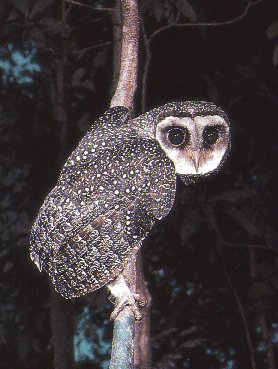

A miniature version of the Sooty Owl that has evolved to live in rainforest
habitat. In order to be able to survive in dense forests, the Lesser
Sooty Owl has had to adapt. In contrast to the Sooty Owl, most of its
prey lives on the ground, the very darkest part of this gloomy environment.
The huge eyes are an obvious help but there is also the problem of the
lack of low perches in the rainforest. The Lesser Sooty Owl has solved
this by learning to cling to the vertical tree trunks like a yellow robin,
enabling it to bring the eyes into play at any height.
David Hollands reported his experience of a Lesser Sooty Owl hunting
successfully on a night of utter blackness while water was streaming
noisily off the trees after a tropical downpour.
(Hollands, D., 1995. "Silent Hunters Of The Night". Nature Australia
Spring 1995. pages 38 - 45).

